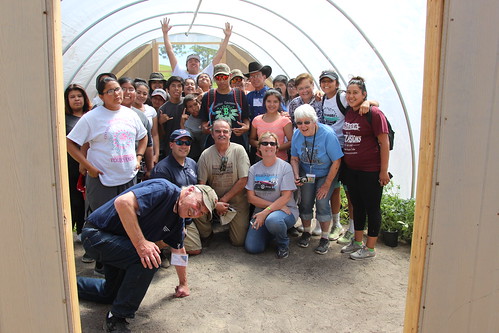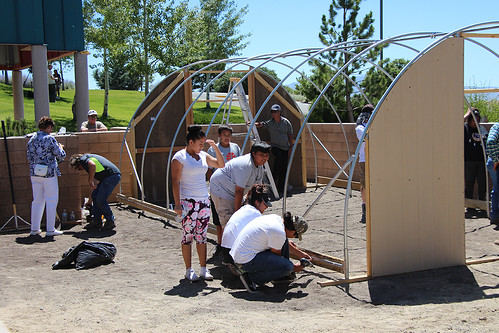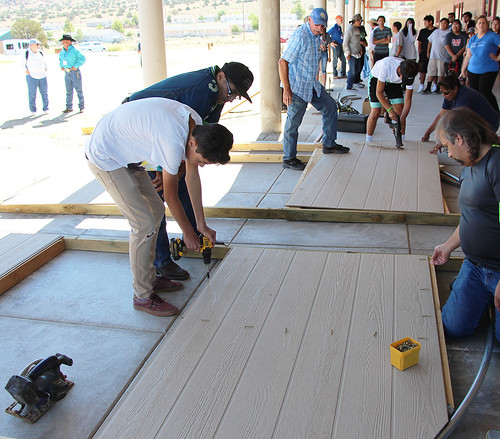
NACR&DC members pose with Reno-Sparks Indian Colony teens to celebrate the finished product.
Squeals of excitement and laughter competed with the sounds of power saws, drills and hammers at the Hungry Valley Child Care Center in Sparks, Nevada, as Reno-Sparks Indian Colony (RSIC) teens were handed power tools for the first time in their lives to assist with building a hoop house.
As part of their life skills learning, the teens helped members of the National Association of Resource Conservation & Development Councils (NARC&DC) who were attending their national conference in Reno, erect a 14’ x 26’ hoop house, with guidance from University of Nevada Cooperative ExtensionFederally Recognized Tribal Extension Program staff and assistance from USDA’s Natural Resources Conservation Service (NRCS).
More than 70 youth employment workers, community volunteers and education department staff were there to assist.
“The purpose of this demonstration project is to highlight the efficiency and effectiveness of hoop houses and to show community members and historically underserved landowners the ease of installation and impact such a structure has in a producer’s operations,” said Andrew Gordon, executive director of NARC&DC. “This project is also designed to help our members learn about: how to increase historically underserved community use of hoop houses from NRCS program participation through EQIP; recommended crops; agencies and organizations available to assist; and other essential information to accommodate a successful hoop house grower experience.”

Reno-Sparks Indian Colony teens try their hands at power tools for the first time, as they learn life skills helping NACR&DC members and University of Nevada Cooperative Extension Federally Recognized Tribal Extension Program staff assemble a hoop house at the reservation.
“The demonstration project showed how hoop houses can improve food supply and extend growing seasons for producers,” said San San Tin, the Reno-Sparks Indian Colony education manager. “The young children at the Child Care and Head Start programs will have an opportunity to learn healthy eating habits by growing their own fruits and vegetables in their garden. By being involved in the process of planting, nurturing and seeing their fruits and vegetables grow, they will be more likely to try eating foods that are healthy.”
According to the USDA, most American Indian reservations, including Hungry Valley, are located in areas with limited access to food. Furthermore, the United States Department of Health & Human Services reports that Native American diets and food practices have changed more (for the worse) than any other ethnic group in the United States. For about the last 200 years, most aspects of the lifestyles of Great Basin Native Americans have changed, including cooking and eating patterns.
Today, although the current diet of Native Americans may vary by tribe, and by personal traits such as age (e.g., young versus old), Native families eat similarly to the rest of the American population. These eating habits have caused serious health problems, such as childhood obesity and diabetes. TheIndian Health Service reports that American Indian and Alaska Native youth, ages 10-19, are nine times more likely as Non-Hispanic white youth to be diagnosed with type 2 diabetes.
At the Reno-Sparks Tribal Health Center, 44 percent or 224 of its 511 youth patients (0-17 years) have been diagnosed as medically overweight or obese.
For complex reasons, Native Americans have experienced high rates of poverty and unemployment, and families often struggle to put enough food, much less healthy food, on their table. One reason is that healthy and fresh foods tend to be more expensive and are often simply unavailable in low-income and rural communities.
“It is very important for Tribal members, young and old, to see that they can have an impact on what they eat,” USDA StrikeForce West Regional Coordinator Sharon Nance said. “In Nevada, theStrikeForce Initiative for Rural Growth and Opportunity—which addresses specific challenges associated with rural poverty—is targeted at Tribes. So after conference attendees learned about StrikeForce efforts as part of their conference, it was great for them to then assist NRCS in placing a hoop house with a local Tribe to enrich their community.”
To learn more about USDA StrikeForce or assistance available through EQIP, visit www.nrcs.usda.govor your local Service Center.

Reno-Sparks Indian Colony teens help NACR&DC members and University of Nevada Cooperative Extension Federally Recognized Tribal Extension Program staff assemble a hoop house at the reservation.
No comments:
Post a Comment
Note: Only a member of this blog may post a comment.